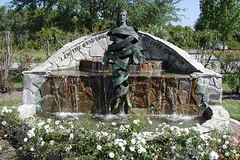
Gentle Readers,
When the apostle Paul tells us to remember Jesus Christ as risen, he is not playing linguistic games with us. He is not affirming the birth of the church as the resurrection body of Jesus. He is not figuratively describing how the disciples "caught" the contagious freedom of Jesus. He is not merely employing a metaphor from his Jewish eschatological expectation to indicate the trans-historical significance of Jesus as the final revelation of God. No, he is affirming the plain literal fact of God's raising him from among the dead, a resurrection that left an empty tomb.
It is because what one scholar has labeled "the evasions of modern theology" have become so depressingly common that I find so striking and so eloquent some lines from a most unlikely source–an Easter poem by the contemporary novelist, John Updike.
Make no mistake: if He rose at all
it was as His body;
if the cells' dissolution did not reverse, the molecules reknit, the amino acids rekindle,
the Church will fall.
It was not as the flowers,
each soft Spring recurrent;
it was not as His Spirit in the mouths and fuddled eyes of the eleven apostles;
it was as His flesh: ours.
The same hinged thumbs and toes,
the same valved heartthat–pierced–died, withered, paused, and then regathered out of enduring Might
new strength to enclose.
Let us not mock God with metaphor,
analogy, sidestepping, transcendence;
making of the event a parable, a sign painted in the faded credulity of earlier ages:
let us walk through the door.
The stone is rolled back, not papier-mache,
not a stone in a story,
but the vast rock of materiality that in the slow grinding of time will eclipse for each of us
the wide light of day.
And if there is an angel at the tomb,
make it a real angel,
weighty with Max Planck's quanta, vivid with hair, opaque in the dawn light, robed in real linen
spun on a definite loom.
Let us not seek to make it less monstrous
for our own convenience, our own sense of beauty,
lest awakened in one unthinkable hour, we are embarrassed by the miracle,
and crushed by remonstrance.
("Seven Stanzas at Easter," written for a religious arts festival sponsored by the Clifton Lutheran Church of Marble head, Massachusetts.)
And yet we must not be so absorbed in defending the concrete, historical reality of the resurrection of Jesus, as the raising of that body that was placed in the tomb, that we fail to appreciate the newness and the glory of that new realm of existence into which Christ entered in his resurrection. As Paul reminds us in I Corinthians 15, the first Adam, and all the children of Adam, have known an existence altogether on the level of psyche–natural, this-age life. But the second Adam has been raised to a new realm, the realm of the pneuma, the life of the spirit, of the Age to Come, a new order of existence the nature of which we can hardly imagine given the severe limitations of our present vision.
Yes, dear brothers and sisters in Christ, this world in which we live is not the only world. And this is not the only age. And with the resurrection of Jesus Christ the end of this age has already begun. The future is now!
Never Fear, Christ has not left you alone He is a real as you or I. He lives within each of us "
I am crucified with Christ: nevertheless I live; yet not I, but Christ liveth in me: and the LIFE which I now live in the flesh I live by the faith of the Son of God, who loved me, and gave himself for me.Paul in the book of Galatians Chapter 2 verse 20



No comments:
Post a Comment